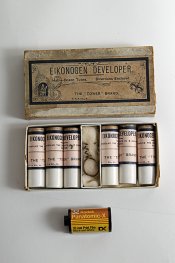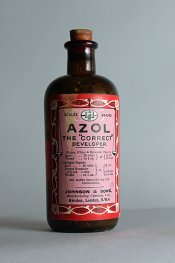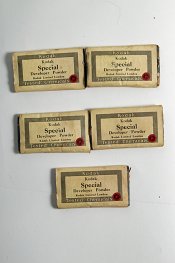Alan Johnson
Subscriber
- Joined
- Nov 16, 2004
- Messages
- 3,283
Here are three I found on ebay:
(1) EIKONOGEN.This I read is similar to metol.It seems to have fallen out of use by 1930 probably because it cost more than metol and possibly does not keep as well.
Hence it has never been used in newer formulas,D-76,Beutler,Microdol,Hutchings Pyro, various 2-bath.So it appears not known if it would be any good.
(2) AZOL.This was one of the developers based on p-aminophenol and believed to be similar to Rodinal.This sample is pre-1948.
(3)KODAK SPECIAL.I found no information about this.Each packet contains two smaller packs to be dissolved in 8oz water.It would develop films,plates and paper.
The smaller packs appear not big enough to contain as much sulfite as D-76 so I conclude it is probably the now obsolete metol-sulfite-carbonate type,but that is a guess.
Any interest in vintage chemicals?
(1) EIKONOGEN.This I read is similar to metol.It seems to have fallen out of use by 1930 probably because it cost more than metol and possibly does not keep as well.
Hence it has never been used in newer formulas,D-76,Beutler,Microdol,Hutchings Pyro, various 2-bath.So it appears not known if it would be any good.
(2) AZOL.This was one of the developers based on p-aminophenol and believed to be similar to Rodinal.This sample is pre-1948.
(3)KODAK SPECIAL.I found no information about this.Each packet contains two smaller packs to be dissolved in 8oz water.It would develop films,plates and paper.
The smaller packs appear not big enough to contain as much sulfite as D-76 so I conclude it is probably the now obsolete metol-sulfite-carbonate type,but that is a guess.
Any interest in vintage chemicals?













 .
.
